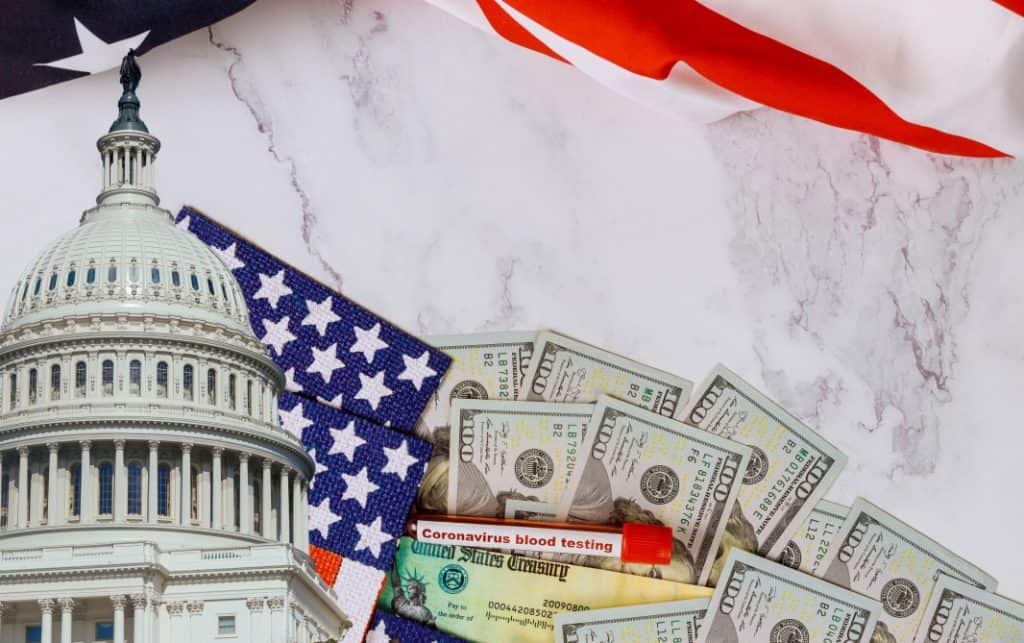This post may contain affiliate links. Click here to read my full disclosure.
The second round of stimulus checks are coming in August 2020, and you’re probably wondering how you should spend it.
While the Cares Act 2 has yet to be fully approved and announced, it is expected that Senate Majority Leader Mitch McConnell will announce specifics of the full program on Monday.
Details on the Second Stimulus Checks & Cares Act 2:
- Recipients will get up to $1200 per person (will likely mirror the previous stimulus check) up to $3900 per family of five.
- Paycheck Protection Plan Sequel – to allow businesses support to continue paying employees
- Changes to the $600 weekly unemployment “bonus” that has incentivized some workers to stay out of work.
How Should You Spend Your Second Stimulus Check?
Let’s start with our top priorities. You need to make sure your four walls are covered.
1. Food and Shelter
Please make sure you’re eating and feeding your family.
You can save money on groceries by creating a written budget for food. If your kids are like mine, they love to snack. I keep this under control by grocery shopping weekly.
Of course, I live right next to a Walmart and Publix, so it’s pretty convenient for me to do so. But before we relocated to Florida from Illinois, we lived 20 miles from Walmart, so I grocery shopped less often.
If you want to know how to save money on groceries, check out my $60 weekly food budget.
Here’s a hint, though: it’s not organic or really healthy at all. It’s simply a cheap meal budget that will keep everyone sustained while you’re living paycheck to paycheck.
As far as shelter goes, your rent or house payment needs to be at the top of your list of priorities.
You might currently be in mortgage forbearance, but soon those payments will be required, and you might even have to pay the total balance owed in full.
Keep all of these factors in mind when deciding how to spend your second stimulus check. Set aside some money for housing if necessary.
2. Open a Separate Checking Account
Part of my budgeting strategy has been to keep a household bills account and a separate expenses account.
My husband’s direct deposit (along with a check I write myself from the business) goes into the “bill account”, and once bills have been paid, I transfer money to savings and to our “expense account”.
The expense account needs to be the one with debit cards so that we can purchase gas, groceries, and any other expenses that aren’t recurring bills.
We like keeping these two accounts separate for two reasons:
- We have no debit cards on our “bill account”, so there is almost no risk. We don’t have to worry about fraudulent purchases.
When I was a banker, I counseled too many families as they patiently waited for provisional credit during a fraud claim investigation. - It keeps us hyper-aware of our spending. We have opted out of debit card overdraft protection, meaning when the account gets to zero, the card is declined.
This is great because if you follow a zero-based budget, you won’t have unexpected overdraft fees as the result of overlooking a purchase.
I recommend Empower Bank as your expense/bill account. This is my own personal bank, and they make it super easy to track finances. They even offer expense tracking (and text you when you’ve spent 50% of your dining out budget, for instance).
When you open and fund your checking account or autosave account, they’ll give you $20 as your own personal stimulus! Pretty sweet, if you ask me!
My favorite feature is that they offer a $150 cash advance with no credit check and no fees. I never recommend payday loans or title loans, but an interest-free advance to put food on the table would be beneficial for so many people!
3. Open an Emergency Fund – Savings Account
If you’re wondering the best way to spend your second stimulus check, this is it.
You need a savings account if you don’t already have one (especially for the unexpected emergencies that might come up).
How long has it been since you’ve had $1,000 in the bank untouched? Consider opening a savings account for emergencies, and it’ll be there if and when you need it.
When you set up auto-save, you can automatically put away a little weekly or every paycheck (whenever it’s best for your budget).
4. Start Preparing for Christmas
Christmas comes December 25 every single year, and some people fail to plan for holiday spending every single year.
Back to school is the best time to go shopping for Christmas! You can save money during tax free weekends, and it’s not just clothes that go on sale!
If you’re in the market for a new iPad, computer, or camera for your daughter’s digital photography class, this might be the time to buy.
Compare prices and deals, and be sure to sign up for a free Rakuten account. Rakuten offers cashback for online purchases when you use their code.
I’ve earned $198 cashback so far this year! It’s totally free, so go sign up now!
How to Budget for Christmas Gifts by Children’s Ages (Hint: Not Equal Dollar Amounts)
5. Pay Off Debt
If you’ve found yourself panicking because you have too much unsecured credit card debt, it’s time to take care of it once and for all.
This is a no-judgment zone. I’ve been there, and I know the struggle, whether you’re an emotional spender or used to pay off credit cards until you decided to start paying minimum payments, and it caught up with you.
That interest has a way of sneaking up on you, doesn’t it?!
I recommend the debt snowball unless you have an incredibly high interest-rate credit card that is just killing you every month.
What’s the debt snowball?
The debt snowball simply listing your debts smallest balance owed to the largest balance owed and paying them off, one by one. If you can pay off more than one with your second stimulus check, do it!
Then cut them up and/or cancel them so that you aren’t tempted to charge them up again. This advice is, of course, provided that you have at least $1,000 in the bank for emergencies.
If you don’t have an emergency fund, you’ll just keep charging emergencies on credit cards.
“But Melissa, won’t my credit score drop if I close my credit card accounts?”
The answer is “Yes, probably.” It’s up to you to decide if you can practice self-control with regards to your spending. Nobody knows you better than you. If you are a spender, it’s best to close them and cut them up.
I’d rather my credit score drop 50-100 points than risk relapsing on a spending addiction. There’s something so freeing about having money instead of debt…IDK.
Melissa Blevins, Perfection Hangover
Wrapping up How to Spend Your Cares Act 2 Money
You need to assess your financial situation and determine what needs the most attention right now.
Then, the day that you receive the check, make specific plans for the funds before they get spent elsewhere.
If you’d like to schedule a financial coaching call to evaluate your debt, budget, and/or just get general advice, you can schedule an appointment here.


Life is a collection of memories and experiences. There are ups and downs. I am so grateful for God’s grace and am on the journey to a renewed spirit, free of perfectionism. Perfection Hangover offers the sober truth – no filter.




This is a great post! I paid down a little debt with my stimulus check as well. It’s so important to budget especially now with these uncertain times.
Pingback: 4 FACTORS THAT AFFECT THE HEALTH OF THE STOCK MARKET
Pingback: How to Stop Exchanging Presents and Have a No Gift Christmas
Great post, Melissa! All great suggestions to make the most of the stimulus checks!
Thanks, Kimberly! I hope you are doing well!! I love following all of your tips at Love to Frugal!